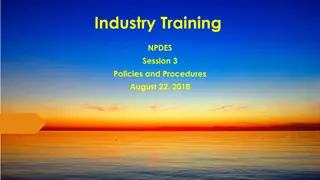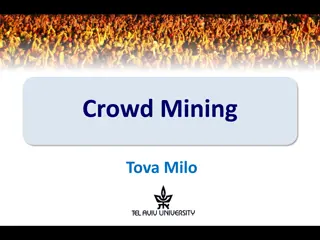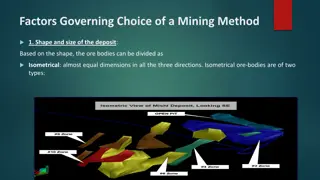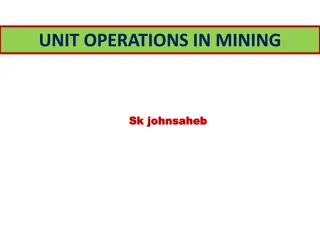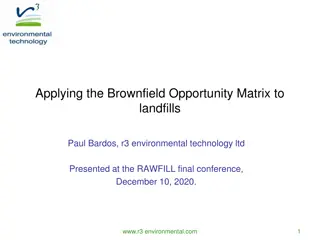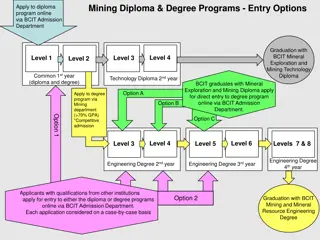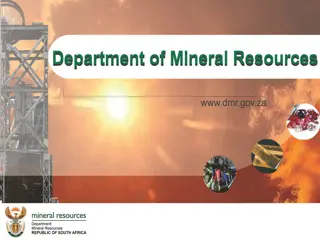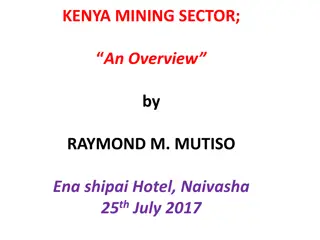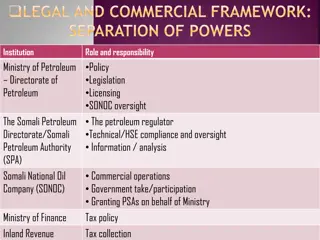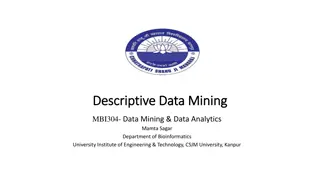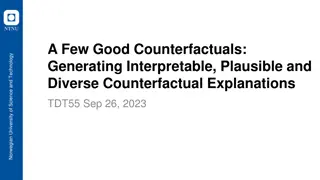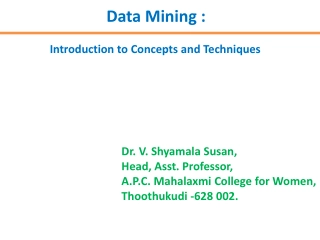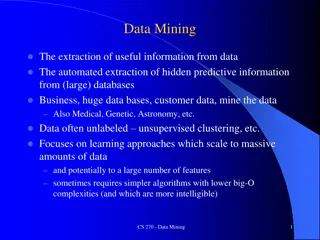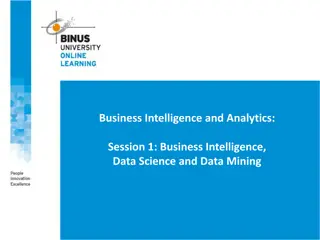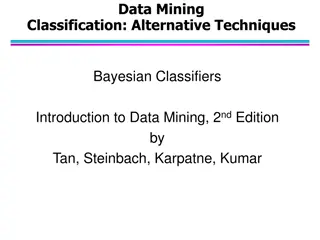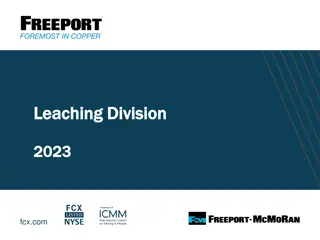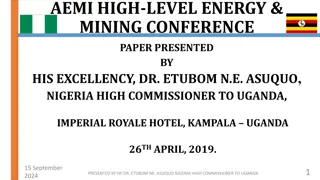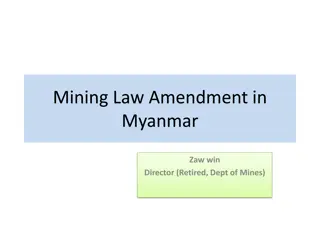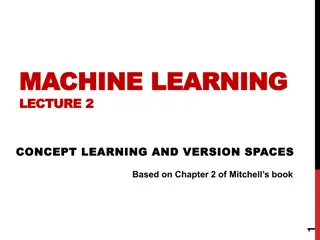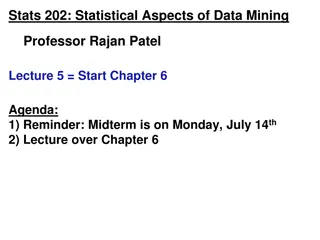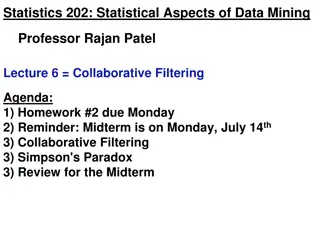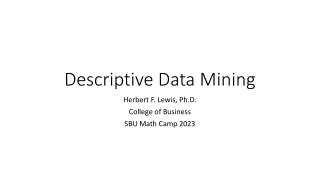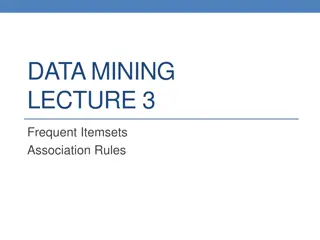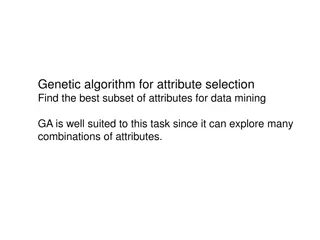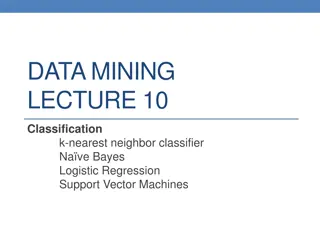Introduction to Instance-Based Learning in Data Mining
Instance-Based Learning, as discussed in the lecture notes, focuses on classifiers like Rote-learner and Nearest Neighbor. These classifiers rely on memorizing training data and determining classification based on similarity to known examples. Nearest Neighbor classifiers use the concept of k-nearest neighbors for classification. The process involves computing distances, identifying nearest neighbors, and determining class labels. Various techniques and definitions related to Nearest Neighbor classification are explained in detail.
Download Presentation

Please find below an Image/Link to download the presentation.
The content on the website is provided AS IS for your information and personal use only. It may not be sold, licensed, or shared on other websites without obtaining consent from the author. Download presentation by click this link. If you encounter any issues during the download, it is possible that the publisher has removed the file from their server.
E N D
Presentation Transcript
Data Mining Classification: Alternative Techniques Lecture Notes for Chapter 4 Instance-Based Learning Introduction to Data Mining , 2nd Edition by Tan, Steinbach, Karpatne, Kumar
Instance Based Classifiers Examples: Rote-learner Memorizes entire training data and performs classification only if attributes of record match one of the training examples exactly Nearest neighbor Uses k closest points (nearest neighbors) for performing classification 02/14/2018 Introduction to Data Mining, 2nd Edition 2
Nearest Neighbor Classifiers Basic idea: If it walks like a duck, quacks like a duck, then it s probably a duck Compute Distance Test Record Training Records Choose k of the nearest records 02/14/2018 Introduction to Data Mining, 2nd Edition 3
Nearest-Neighbor Classifiers Unknown record Requires three things The set of labeled records Distance Metric to compute distance between records The value of k, the number of nearest neighbors to retrieve To classify an unknown record: Compute distance to other training records Identify k nearest neighbors Use class labels of nearest neighbors to determine the class label of unknown record (e.g., by taking majority vote) 02/14/2018 Introduction to Data Mining, 2nd Edition 4
Definition of Nearest Neighbor X X X (a) 1-nearest neighbor (b) 2-nearest neighbor (c) 3-nearest neighbor K-nearest neighbors of a record x are data points that have the k smallest distances to x 02/14/2018 Introduction to Data Mining, 2nd Edition 5
1 nearest-neighbor Voronoi Diagram 02/14/2018 Introduction to Data Mining, 2nd Edition 6
Nearest Neighbor Classification Compute distance between two points: Euclidean distance = ( , ) ( 2) d p q p q i i i Determine the class from nearest neighbor list Take the majority vote of class labels among the k-nearest neighbors Weigh the vote according to distance weight factor, w = 1/d2 02/14/2018 Introduction to Data Mining, 2nd Edition 7
Nearest Neighbor Classification Choosing the value of k: If k is too small, sensitive to noise points If k is too large, neighborhood may include points from other classes X 02/14/2018 Introduction to Data Mining, 2nd Edition 8
Nearest Neighbor Classification Scaling issues Attributes may have to be scaled to prevent distance measures from being dominated by one of the attributes Example: height of a person may vary from 1.5m to 1.8m weight of a person may vary from 90lb to 300lb income of a person may vary from $10K to $1M 02/14/2018 Introduction to Data Mining, 2nd Edition 9
Nearest Neighbor Classification Selection of the right similarity measure is critical: 1 1 1 1 1 1 1 1 1 1 1 0 0 0 0 0 0 0 0 0 0 0 0 1 vs 0 1 1 1 1 1 1 1 1 1 1 1 1 0 0 0 0 0 0 0 0 0 0 0 Euclidean distance = 1.4142 for both pairs 02/14/2018 Introduction to Data Mining, 2nd Edition 10
Nearest neighbor Classification k-NN classifiers are lazy learners since they do not build models explicitly Classifying unknown records are relatively expensive Can produce arbitrarily shaped decision boundaries Easy to handle variable interactions since the decisions are based on local information Selection of right proximity measure is essential Superfluous or redundant attributes can create problems Missing attributes are hard to handle 02/14/2018 Introduction to Data Mining, 2nd Edition 11
Improving KNN Efficiency Avoid having to compute distance to all objects in the training set Multi-dimensional access methods (k-d trees) Fast approximate similarity search Locality Sensitive Hashing (LSH) Condensing Determine a smaller set of objects that give the same performance Editing Remove objects to improve efficiency 02/14/2018 Introduction to Data Mining, 2nd Edition 12
KNN and Proximity Graphs Proximity graphs a graph in which two vertices are connected by an edge if and only if the vertices satisfy particular geometric requirements nearest neighbor graphs, minimum spanning trees Delaunay triangulations relative neighborhood graphs Gabriel graphs See recent papers by Toussaint G. T. Toussaint. Proximity graphs for nearest neighbor decision rules: recent progress. In Interface-2002, 34th Symposium on Computing and Statistics, ontreal, Canada, April 17 20 2002. G. T. Toussaint. Open problems in geometric methods for instance based learning. In Discrete and Computational Geometry, volume 2866 of Lecture Notes in Computer Science, pages 273 283, December 6-9, 2003. G. T. Toussaint. Geometric proximity graphs for improving nearest neighbor methods in instance-based learning and data mining. Int. J. Comput. Geometry Appl., 15(2):101 150, 2005. 02/14/2018 Introduction to Data Mining, 2nd Edition 13




